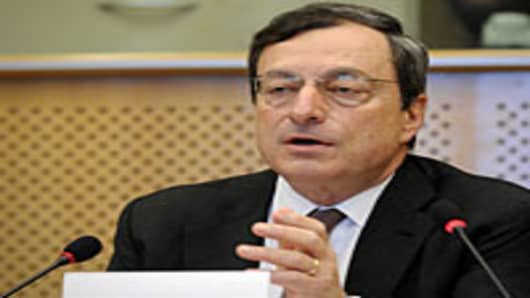Draghi repeated that before any bond buying begins, two conditions need to be fulfilled: The adherence of governments to their commitments and the fulfillment by the European Financial Stability Facility (EFSF)/European Stability Mechanism (ESM) of their role.
No government has applied for aid yet, and the ESM is not yet active. So no active program is being announced.
He repeated what could now be called the "Draghi Principles": We act strictly within our mandate to maintain price stability over the medium term; we act independently in determining monetary policy; and the euro is irreversible.
Other points made by Draghi:
1) A broader range of collateral will be accepted for repos; and
2) inflation forecast was raised to 2.5 percent, from 2.4 percent.
A couple questions I have been asked:
1) Why, with the European economy in recession (learn more), did Draghi not cut interest rates? He didn't say, but one answer is the inflation (learn more) forecast, raised slightly to 2.5 percent, the high end of the ECB's comfort range of 2 percent. He said "inflation rates are expected to remain above 2 percent throughout 2012."
The main reason, however, is likely that Draghi doesn't think a rate cut will matter. He likely doesn't think that will address the problems they are facing. A quarter point cut in rates is not going to help Spain.
They are, in the words of Draghi, deep in "nonstandard" territory.
2) Why didn't the market move up on the news of the bond-buying program? S&P 500 futures, which were higher prior to the Draghi news conference, have been flat to slightly lower since.
This is likely because Draghi was fairly downbeat on the economic assessment. Gross domestic product (learn more) growth has been revised downward. Full-year GDP projections for the euro area are now in a range between DOWN 0.6 percent and DOWN 0.2 percent for 2012, and between DOWN 0.4 percent and UP 1.4 percent for 2013. The prior low range for 2012 was down only 0.1 percent, it is now down 0.4 percent.
The annual growth rate of loans to the private sector remained weak at 0.5 percent in July, after 0.3 percent in June, Draghi noted.
—By CNBC’s Bob Pisani
_____________________________
Bookmark CNBC Data Pages:
_____________________________
Want updates whenever a Trader Talk blog is filed? Follow me on Twitter: twitter.com/BobPisani.
Questions? Comments? tradertalk@cnbc.com



